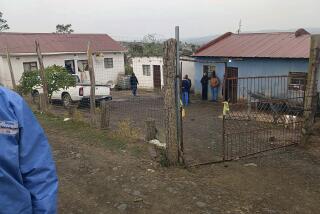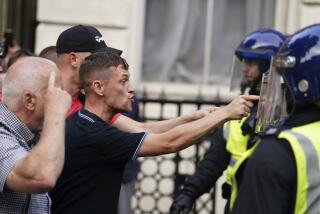S. African Black Youths Attack Whites’ Homes : Gunfire Drives Off Raiders; 2 Wounded
- Share via
CAPE TOWN, South Africa — For the first time in South Africa’s year of civil unrest, black and mixed-race youths attacked whites in their homes overnight Thursday but were driven off by shotgun and pistol fire.
A group of 150 mixed-race Coloreds attacked half a dozen homes in Windsor Park, a white suburb of Cape Town, bombarding them with stones and then throwing firebombs.
Residents fired pistols and shotguns from behind barricaded windows, wounding at least two of the attackers, one 16 years old and the other 25, who were later arrested. No whites were hurt, police said, and there was little damage.
In a similar incident at Amalinda, a suburb of East London 550 miles east of here, black youths attacked two white homes, again hurling firebombs at them, before one of the residents drove them off with gunfire. No injuries were reported there, and damage was described as minor.
White motorists have been stoned and sometimes assaulted by black youths, and two whites were killed last weekend in an incident outside East London. But this was the first time that white suburbs have been attacked--the first time that the racial violence of the past year has been taken to the homes of the ruling white minority.
This development followed calls by black radicals here and by the African National Congress broadcasting on the organization’s Radio Freedom to take the “fires of the revolution” into white areas. The attacks on whites also prompted a flying visit to Cape Town on Thursday by Law and Order Minister Louis le Grange and Defense Minister Magnus Malan.
Whites here and in East London immediately began buying large stocks of ammunition and additional weapons, according to local gun dealers, and local clergymen at Kraaifontein, the Cape Town suburban area where Windsor Park is located, expressed fears that the conflict would escalate into a “race war . . . unless urgent measures are taken.”
White sentiment was summed up by Fanie Visser, a Kraaifontein shopkeeper on the border between Windsor Park, a working-class suburb, and Scottsdene, the neighboring Colored township from which the violence spilled over. “If they come again there will be too many bodies to count,” Visser warned.
“If there is another attack, even a feeble one like last night, we will be ready with our guns loaded, and we won’t hesitate a second before we shoot,” he said as he cleaned his pump-action shotgun and filled a cartridge belt with shells. “And, one more thing, we won’t stop shooting until they are all dead. People will have to do something to defend themselves, and remember we are outnumbered five or six to one.”
Andries P. Treurnicht, leader of the ultraright Conservative Party, who warned the government Wednesday of a “white resistance movement” unless the unrest is ended, said after the attacks here and in East London, “The white backlash has started already and will grow quickly.”
Of the more than 675 persons killed in the unrest of the past year, four have been white--an infant hit by a rock when his mother’s car was stoned, a middle-aged nurse who was pulled from her car and beaten and the two white construction workers who drove into a group of black youths outside East London, injuring 11, and were beaten and stabbed when they tried to drive away.
“All these months, the battlefield has been confined to the areas where we, the oppressed black people, live securely far away from the white areas of the country,” Radio Freedom said earlier this week in a commentary that frightened many here, coming as it did after similar speeches at funerals for recent victims of violence. “The whites of this country now have to be rudely awakened from the dreamland that they have closed themselves into.
“We now have to take the battle right into their homes, into their kitchens and bedrooms. . . . Together, we must now devise new ways of carrying the battlefield right into the enemy’s rear base, into the white areas of the country.”
Little was said of Le Grange’s and Malan’s discussions with police and military commanders here, but security forces took even tougher action Thursday against groups of Colored youths protesting government policies and demanding an end to apartheid, South Africa’s system of racial separation and minority white rule.
Fierce battles raged through most of the day in at least eight of the Colored townships that ring Cape Town. Dozens of youths were wounded as police fired shotguns loaded first with birdshot and then with heavier buckshot.
Three Colored men were reported killed in clashes with police overnight at Elsie’s River, a predominantly Colored community north of here, and at a bus stop on the road to Stellenbosch, also to the north.
Local leaders expressed fears that the death toll from Thursday could be much higher.
Thirty persons, all Colored or black, have been killed here, according to police figures, since the upsurge in unrest began last week. The flare-up was sparked by the arrest of the Rev. Allan Boesak, a prominent anti-apartheid activist from Cape Town’s Colored community. And it was marked by tough police action to break up a march Boesak had planned to the prison where Nelson Mandela, the black nationalist leader, is serving a life sentence for sabotage.
But the official figures appear to omit at least half a dozen deaths.
Under orders to break up all protest meetings Thursday, the police fired volleys of tear-gas grenades at virtually all gatherings--not only the large rallies held at area high schools but at even five people on the front porch of a home.
As the clashes increased in intensity in Athlone, the focus of much of the fighting in the last week here, police turned on the South African and foreign press, firing tear-gas grenades at them and then chasing them with plastic whips through the Belgravia neighborhood, to force them to leave the area.
The camera crew for the British-owned World Television News and a photographer for Agence France-Presse were badly beaten, and a television camera was smashed by police. Other newsmen, pursued by policemen, scattered through Belgravia, taking refuge in homes and shops, hiding under beds, in cupboards and, in one case, in the meat cooler of a Muslim butcher shop.
The only explanation came from a police captain on the scene, who refused to identify himself, but said, “You damn meddlers are making all this worse and getting in our way. Today, we used tear smoke and quirts (whips), but tomorrow it will be birdshot if you come back.”
More to Read
Sign up for Essential California
The most important California stories and recommendations in your inbox every morning.
You may occasionally receive promotional content from the Los Angeles Times.













